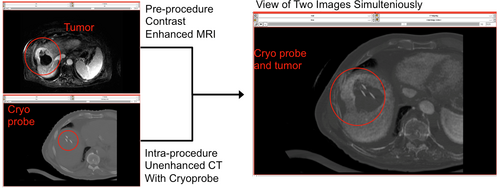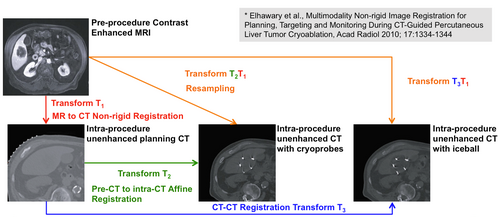Difference between revisions of "Non-rigid MR-CT Image Registration"
| Line 14: | Line 14: | ||
*Non-rigid registrations desirable to compensate for liver deformation caused by patient positioning, respiratory motion, and interventional manipulation. | *Non-rigid registrations desirable to compensate for liver deformation caused by patient positioning, respiratory motion, and interventional manipulation. | ||
*A multi-modality non-rigid registration method can enhance visualization of tumor margins and location during the planning, targeting, and monitoring phases of CT imaging-guided cryoablation procedure. | *A multi-modality non-rigid registration method can enhance visualization of tumor margins and location during the planning, targeting, and monitoring phases of CT imaging-guided cryoablation procedure. | ||
| + | |||
| + | |||
| + | === Tutorial Topics / Targets === | ||
| + | * Slicer Modules Used: | ||
| + | ** N41ITKBiasField Correction | ||
| + | ** Editor | ||
| + | ** BRAINSFitIGT Registration | ||
| + | |||
Revision as of 20:03, 13 June 2011
Home < Non-rigid MR-CT Image Registration

Contents
Non-rigid MR-CT Image Registration Tutorial
Overview
This tutorial demonstrates how to perform a pre-operated contrast enhanced MR image to intra-procedure CT image non-rigid registration. The case study is CT-guided liver tumor cryoablation.
Clinical significants
- Non-rigid registrations desirable to compensate for liver deformation caused by patient positioning, respiratory motion, and interventional manipulation.
- A multi-modality non-rigid registration method can enhance visualization of tumor margins and location during the planning, targeting, and monitoring phases of CT imaging-guided cryoablation procedure.
Tutorial Topics / Targets
- Slicer Modules Used:
- N41ITKBiasField Correction
- Editor
- BRAINSFitIGT Registration
In this tutorial, the three steps are performed as shown the figure on right side.
- (1) In the image registration between MR image and planning CT image, we can obtain the moved and deformed MR image and the Bspline transformation matrix T1 by using pre-procedure contrast enhanced MRI and mask image.
- (2) In the image registration between plannning CT image and intra-procedure CT image, we can obtain the moved and deformed planning CT image and the Bspline transformation matrix T2.
- (3) In the image registration between MR image and intra-procedure CT image, we can obtain the moved and deformed MR image by using T1 and T2 BSpline transformation matrices.
For non-rigid registration, BRAINSFitIGT and BRAINSResamle modules are used. In this tutorial, we will show that 3D Slicer with BRAINSFitIGT module allows performing non-rigid image registration and BRAINSResample module allows performing non-rigid image deformation using Bspline transform matrix. We also shows the non-rigid registration method can enhance visualization of tumor margins and location during the planning, targeting, and monitoring phases of CT imaging-guided cryoablation procedure.
Tutorials
Non-rigid MR-CT Image Registration Module tutorial : to perform MR-CT and CT-CT image registration [ppt] [pdf]
Tutorial materials
Material data:
People
Atsushi Yamada, Ph.D. (Research Associate, Brigham and Women's Hospital and Harvard Medical School)
Dominik S. Meier, Ph.D. (Assistant Professor, Brigham and Women's Hospital and Harvard Medical School)
Nobuhiko Hata, Ph.D. (Associate Professor, Brigham and Women's Hospital and Harvard Medical School)